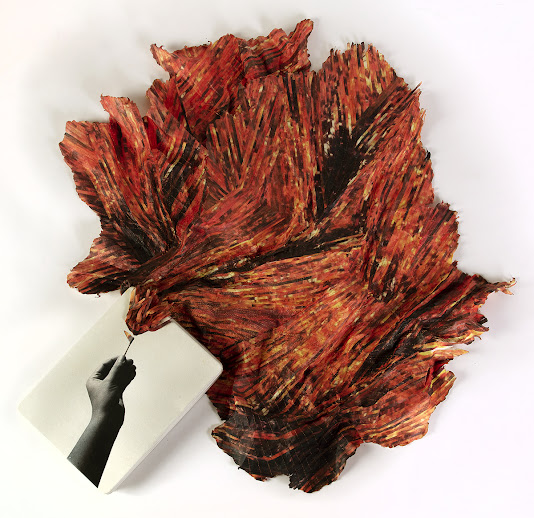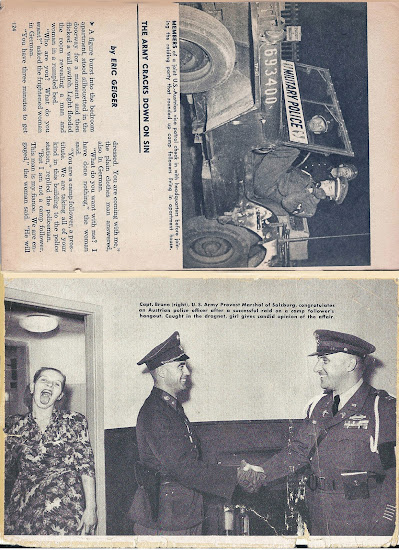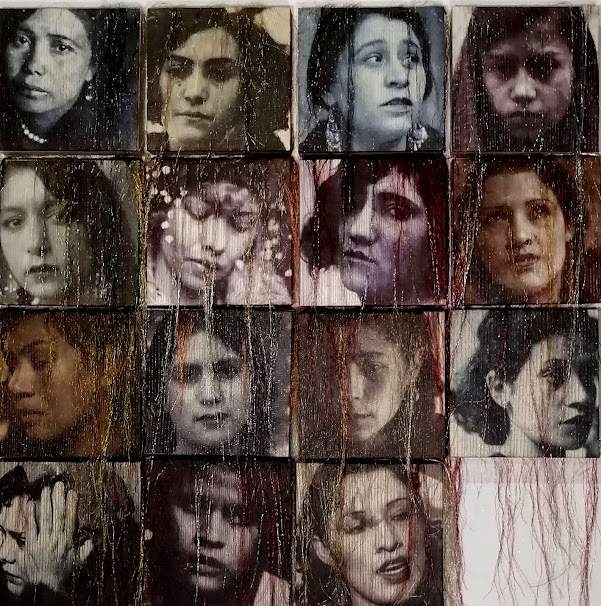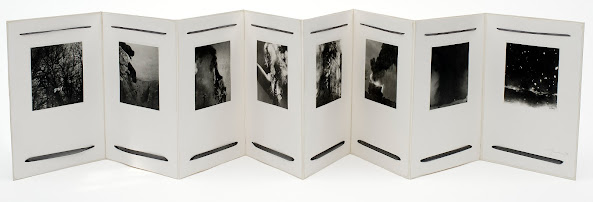On December 15th in the Victoria and Albert Museum, London, the ninth edition of the Prix Pictet was inaugurated. A panel discussion examining the theme, "Fire" as well aspects of the work of various of the shortlisted photographers and artists, had been planned for that same afternoon, but was canceled for concerns about Covid. As I already had prepared my presentation, I've decided to present it here.
El 15 de diciembre en el museo Victoria and Albert, Londres, se inauguró la edición nueve del Prix Pictet. Estaba calendarizado una discusión del tema del premio, "Fuego", y aspectos de la obra de varios de sus finalistas para la tarde de la inauguración, pero la mesa redonda se tuvo que cancelar por el tema del Covid. Como ya tenía preparada mi intervención, la asiento aquí.
Fire- Fuego (o, La caja de Pandora- Pandora's Box) 2009 (versión 2021)
Carla Rippey: I am actually a visual artist, not a photographer, although my father was a photographer and photojournalist and so I grew up with photographic concepts –ideas about composition, cropping, juxtaposition and the creation of visual narratives. In fact, I figured out a few years ago that probably my biggest influences were patchwork quilts, and Edward Steichen’s book “The Family of Man”. From early on as an artist, I’ve worked with archives, and what is now called appropriation, collecting the images that catch my eye or create an echo for me. Here we see my part of my archives for the work in this show.
La verdad, soy artista visual, no fotógrafa, pero mi padre sí fue fotógrafo y fotoperiodista y así crecí familiarizada con conceptos fotográficos-- ideas sobre composición, encuadres y yuxtaposición y la creación de narrativas visuales, por ejemplo. Es más, hace unos años me di cuenta que mis influencias más grandes como artista han sido, probablemente, las colchas de parches (patchwork) del medio oeste y el libro/catálogo de Edward Steichen, "The Family of Man". Desde hace mucho, como artista he trabajado con archivos, y con lo que ahora se llama "apropiación", coleccionando las imágenes que me llaman la atención o que crean un eco para mí.
Around 1990 I started making artist’s books and installations with photocopies transferred with paint thinner onto Japanese and other papers and cloth. This work is a sort of mid-life piece made from my archives of vanishing points, called “From the Finite to the Infinite”. My work is always extremely personal, I start off trying to articulate something for myself, with the hope that the work will resonate on another level, for others.
Cerca de 1990 empecé a hacer libros de artista e instalaciones con fotocopias transferidas con solvente a papeles japoneses y otros, y tela. Esta pieza es una especie de pieza de la mitad de la vida hecho con mis archivos de puntos de fuga, llamada "Del finito al infinito". Mi obra suele ser bastante personal; empiezo tratando de articular algo para mi misma, con la esperanza que la obra pueda resonar para los demás, en algún nivel, en algún momento.
About the Prix Pictet: / Sobre el Prix Pictet:
"The Prix Pictet aims to harness the power of photography – all genres of photography – to draw global attention to issues of sustainability, especially those concerning the environment.
Founded in 2008 by the Pictet Group, the Prix Pictet has become the world’s leading award for photography and sustainability. To date, there have been eight cycles of the award each of which has highlighted a particular facet of sustainability. The nine themes are Water, Earth, Growth, Power, Consumption, Disorder, Space, Hope and Fire."
El Prix Pictet busca aprovechar el poder de la fotografía -todos los géneros de fotografía - para atraer atención global a asuntos de sustentabilidad, particularmente en referencia al medio ambiente.
Fundada en 2008 por el Grupo Pictet, el Prix Pictet se ha vuelto el principal premio mundial en el campo de fotografía y sustentabilidad. Hasta ahora, han habido ocho ciclos del premio; cada uno ha enfatizado un aspecto particular de sustentabilidad. Los nueve temas son Agua, Tierra, Crecimiento, Poder, Consumo, Desorden, Espacio, Esperanza y Fuego.
"Entry to the award is strictly by nomination. The network of nominators worldwide (currently numbering 300) have, over the course of the eight cycles, nominated 4,700 artists for the award. Taken together the nominated works present a powerful testament to the fragile state of our planet.
Since 2008 the eight cycles of the Prix Pictet have been shown in exhibitions in many major cities of the world with visitor numbers of over 550,000."
Entrada al premio es estrictamente por nominación. La red de nominadores mundialmente (en este momento son más que 300) ha nominado, sobre el transcurso de ocho ciclos, 4,700 artistas para el premio. Tomadas juntas, las obras nominadas presentan un testamento poderoso al estado frágil del planeta.
Desde 2008 los ocho ciclos del Prix Pictet han sido presentados en exposiciones en muchas ciudades significantes de mundo, con el número de visitas arriba de los 550,000.
Virtual tour of the present exhibit in the Victoria and Albert Museum / Tour virtual de la exposición actual en el museo Victoria y Albert: https://my.matterport.com/show/?m=77Yddda3d4d
Portfolios de los finalistas del Prix Pictet 2021 / Portfolios of the 2021 Prix Pictet shortlisted artists- Joana Hadjithomas and Khalil Joreige, Lisa Oppenheim, Mak Remissa, Mark Ruwedel, Rinko Kawauchi, Sally Mann, Brent Stirton, Carla Rippey, Christian Marclay, Daisuke Yokota, David Uzochukwu y / and Fabrice Monteiro https://prixpictet.com/portfolios/
_________________________________________________________________________________
Artist's statement / Comentario de la artista Prix Pictet, Carla Rippey
I started collecting images and working from the resulting archives in the late 1970s; one of the subjects that emerged with time was that of vanishing points, another was fire: the act of burning registered in reiterated images clipped from newspapers, magazines and later on, downloaded from the internet.
When laser photocopies were commercialized in late 1980s, I discovered that the toner from the photocopies could be transferred with solvent and an etching press to Japanese papers and began to apply the practice to the making of artist’s books. Starting around 2010, with this technique I made a series of artist’s books with the fire images, a series called “Immolation”.
Empecé a coleccionar imágenes y trabajar con los archivos resultantes en fines de los 1970; uno de los temas que surgió con el tiempo fue el de puntos de fuga, otro fue fuego: el de acto de quemar registrado en imágenes reiteradas recortadas de periódicos, revistas, y más adelante, bajadas del internet.
Cuando la fotocopia láser se comercializó en fines de los 1980s, descubrí que el tóner de las fotocopias se podría transferir con solvente (thinner) y un tórculo de grabado a papeles japoneses y empecé a aplicar este proceso a la hechura de libros de artista. Alrededor de 2010 empecé a hacer una serie de libros con imágenes de fuego de mis archivos, una serie llamada "Inmolación".
At first, I juxtaposed images of volcanoes and people set on fire (lynchings in Mexico), throwing fire (Palestinians) or setting themselves on fire in acts of desperation. Fire seemed like the ultimate manifestation of uncontrolled energy, energy gone bad, and besides, fire burns the eye: it has an enormous visual impact. The fiery acts of humans were an echo of the eruptions of volcanoes and the volcanoes, a metaphor for people out of control. A later artist’s book in the series, “The cloister”, juxtaposes a face cropped from an old postcard of a Japanese nun with a stereoscopic image of a lotus pond; this work is about contained or trapped fire, burning from within. The books are collaged or patchworked together, intervened with stitching and metal leaf; the rims of the books are scorched. In the work “Fire”, on the cover of a metal box, a hand holds a match to the crumpled mass of fire emerging from within. The title should really be "Pandora's Box".
En un principio, yuxtaponía imágenes de volcanes y personas en llamas (linchamientos en México), tirando fuego (palestinos) or prendiéndose fuego en actos de desesperación. El fuego me parecía la última manifestación de energía descontrolada, energía maleada, y además, el fuego quema el ojo: tiene un impacto visual tremendo. Un libro de artista de los últimos de la serie, "El claustro" yuxtapone una cara recortada de una postal vieja de una monja japonesa, con una tarjeta estereoscópica de un estanque de lotos; esta obra se trata de fuego contenido o atrapado, quemando desde adentro. Los libros están armados con collage or parches, intervenidos con costura y hoja metálica; los bordes están quemados. En la obra "Fuego", en la tapa de una caja de latón, una mano sostiene un cerillo del cual emerge una masa arrugada de fuego que emerge desde adentro de la caja. El título debe ser, más bien, "La caja de Pandora".
The Cloister / El claustro 2011
Growing out of my original interest in fire, I started working with the idea of “Women, Fire and Dangerous Things”. This is the title of the book by the linguist George Lakoff, who discusses therein an aboriginal tribe- the Dyirbal- in Australia whose language includes four genders, one of which is defined principally by women, fire and dangerous things. I was struck by the fact that the Dyirbal consider these three categories to be naturally related, and this inspired me to put together new archives working with images generated by the phrases “women, fire” or “dangerous objects” put into Google search. The results were surprising and sometimes shocking. “Women, fire” came up with a surfeit of situations related to the abuse of women. With the words “dangerous objects” I found a number of X Rays of unusual objects that people and animals had somehow managed to swallow; asteroids came up continually.
Al seguir con mi interés original en el fuego, empecé a trabajar con la idea de "Mujeres, fuego y objetos peligrosos". Viene del título de un libro del linguïsta george Lakoff ("Women, Fire and Dangerous Things"), quien allí comenta una tribu indígena de Australia, -los Dyirbal- cuyo idioma incluye cuatro géneros, uno de los cuales se define principalmente por mujeres, fuego y cosas peligrosas. Me impresionó el hecho de que los Dyirbal consideran que estas tres categorías están relacionadas intrínsecamente, y me inspiró a crear nuevos archivos con las imágenes generadas por las frases "mujeres, fuego" u "objetos peligrosos" metidas en búsqueda de Google. Los resultados fueron sorprendentes y a veces, terribles. "Mujeres, fuego", arrojó un sinnúmero des situaciones involucrando el abuso de mujeres. Con las palabras "objetos peligrosos" encontré bastantes rayos X de objetos inusuales que personas y animales de alguna manera habían logrado tragar; asteroides también salían continuamente.

































